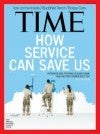Once again, TIME magazine has published its annual issue devoted to national service. A partner with the 21st Century National Service Summit, the magazine comes out just in time for the event, from June 24 to 26, produced by The Aspen Institute Franklin Project.
Managing Editor Richard Stengel and columnist Joe Klein ask if and “How Service Can Save Us.” Both offer the Summit and The Franklin Project as ways to consider national service anew. Read below for Stengel’s editor’s letter and an excerpt from Klein’s cover story:

Service Is a Silver Bullet
By Richard Stengel
Six summers ago, we published a cover story called “The Case for National Service,” in which I proposed that every American high school student do a year of service after graduation. While there have been gains over the past six years–such as a new focus on addressing the high school–dropout epidemic through service and the establishment of a social-innovation fund to scale programs that work–the idea of national service has moseyed along without much progress. Until now.
This summer, TIME, in collaboration with the Aspen Institute’s Franklin Project and its chairman, General Stanley McChrystal, is convening a 21st Century National Service Summit in Aspen, Colo.
The plan of action represents a powerful evolution of that earlier vision, with a better balance between military and civilian service. The movement is headed by the nation’s former top commander in Afghanistan and endorsed by a stellar group that includes two former Secretaries of State, Condoleezza Rice and Madeleine Albright. The plan calls for universal national service for every 18- to 28-year-old and proposes that we open up the GI Bill to support returning veterans who want to do a year of civilian service in organizations like Team Rubicon, Habitat for Humanity and the Mission Continues, the last of which is the subject of Joe Klein’s powerful cover story in this issue.
In this multifaceted plan, every young American has the option of serving in one of five branches of the military or one of a number of civilian national-service corps, bringing together young adults from different backgrounds and places to address challenges in education, conservation, health, poverty and reintegration of veterans back home. The plan envisions young professionals–lawyers, health care professionals and people in business–using their skills to help those in need. The initial goal is to create positions for 1 million full-time civilian national-service workers–nearly equal to the number of Americans who serve on active duty in our armed forces every year. The plan calls on colleges and universities, nonprofits, faith-based groups and social enterprises to become certified as national-service organizations and to offer full-time service positions. Citizens could support these efforts by crowdfunding, a Kickstarter for national service.
In addition to the existing Peace Corps and Corporation for National and Community Service, which oversees AmeriCorps, VISTA and Senior Corps, other parts of the government are starting service projects as an efficient and low-cost solution to big problems. FEMA is planning to save $60 million by using full-time national-service participants in disaster preparedness and response. Education Secretary Arne Duncan launched the School Turnaround AmeriCorps. Other departments and agencies could follow suit. A poll of registered voters supported by Target shows that 80% support voluntary national service that offers a living allowance and education award.
I believe service can help us deal with a multitude of national problems, from unemployment to education to adapting immigrants to American society. And it can and will foster a generation of leaders who can work together to get big things done for our country.
Richard Stengel, MANAGING EDITOR
Read an excerpt below from TIME‘s cover story below:
Can Service Save Us?
By Joe Klein
It just might. By helping returning troops regain their sense of purpose, veterans’ groups are proving that public service is therapeutic
There was absolutely no way Ian Smith was suffering from posttraumatic stress disorder. He was sure of it.
He was O.K. He was living with his girlfriend in a suburb of Nashville working three jobs — mowing lawns, delivering pizzas, cleaning a local church. He was carrying a 4.0 average at Volunteer State Community College. Yes, he’d seen some terrible stuff during two tours in Iraq. But others had been through much worse. He’d never been wounded. He was alive.
But it was a strange sort of alive. He lived on his couch, with his pistol. He didn’t sleep much. The only way he could get to sleep was by getting drunk, so he got drunk every night and slept with his gun under the pillow. He had gained 60 lb. since leaving the Army in February 2009. He drank more and more. His girlfriend left him. He put the gun to his head several times. “He absolutely refused to believe he was suffering from PTSD,” said his buddy Mike Pereira, a fellow Army intelligence analyst. “But I wasn’t going to let him alone.” Read the full article here.
